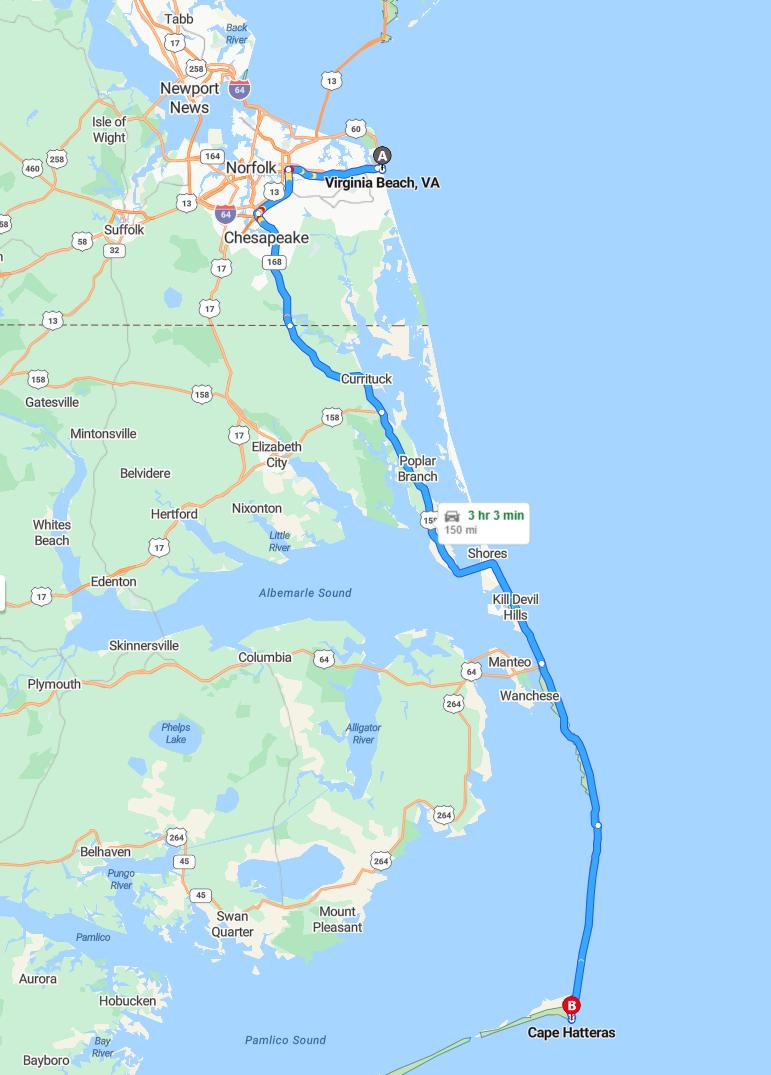Distance and estimated driving time
The drive from Virginia Beach to Cape Hatteras typically takes approximately 3 hours and 3 minutes, covering around 150 miles. The most common route involves taking US-158 E followed by NC-12, providing a scenic journey through the coastal landscapes of North Carolina. Travelers should plan for potential delays, especially during peak tourist seasons, as this route is popular for beachgoers. Ensure your vehicle is prepared for the trip, and consider stopping at points of interest along the way to enhance the overall experience.
Driving route
Traveling from Virginia Beach to Cape Hatteras offers a scenic journey through the scenic coastlines of North Carolina. Starting in Virginia Beach, the route takes you through the charming communities of Currituck and Poplar Branch, providing glimpses of local culture and waterfront views. Continuing south, you'll pass through Shore and Kill Devil Hills, famous for its historical significance in aviation history. The journey then leads to Manteo and Wanchese, where you can explore quaint harbor towns and enjoy fresh seafood. Finally, reaching Cape Hatteras, travelers are rewarded with stunning beaches, iconic lighthouses, and the natural beauty of the Outer Banks.

Best time to travel
The best time to travel from Virginia Beach to Cape Hatteras is during the spring (April to early June) and fall (September to October) when the weather is mild and the crowds are smaller. Traveling in these shoulder seasons allows for comfortable driving conditions and the opportunity to enjoy local attractions without the peak tourist rush. Summer months (July and August) tend to be busier, with higher temperatures and more visitors, making travel somewhat more congested. Visiting during off-peak times also enhances the experience by providing better access to scenic stops like Currituck, Kill Devil Hills, and Manteo, ensuring a more relaxed trip along this picturesque route.
Road conditions and potential delays
Traveling from Virginia Beach to Cape Hatteras, drivers should be aware that road conditions can vary, especially during peak tourist seasons, with potential for heavier traffic around popular stops like Kill Devil Hills and Manteo. Coastal areas such as Currituck and Wanchese sometimes experience fog and mist, which can reduce visibility and require extra caution. Additionally, seasonal weather events like hurricanes or tropical storms may lead to road closures or delays, particularly on external routes to Cape Hatteras. It is advisable to check current traffic updates before the trip to ensure smooth travel and to plan for possible delays along this scenic route.
Scenic spots along the route
As you journey from Virginia Beach to Cape Hatteras, you'll pass through several scenic spots worth exploring. In Currituck, enjoy the panoramic views of the Currituck Sound, known for its tranquil waters and abundant birdlife. Continuing through Kill Devil Hills, stop at the Wright Brothers National Memorial to appreciate the site of the first powered flight. Near Manteo and Wanchese, explore the historic waterfront and maritime museums, offering a glimpse into the area's rich coastal heritage before reaching the breathtaking Cape Hatteras Lighthouse.
Fuel stops and charging stations
When driving from Virginia Beach to Cape Hatteras, it is essential to plan for fuel stops and charging stations along the route to ensure a smooth journey. Major towns such as Currituck, Kill Devil Hills, and Manteo offer convenient fueling options, with many gas stations available for quick refueling. For electric vehicle travelers, charging stations are increasingly accessible in key locations like Kill Devil Hills and Manteo, providing a practical solution for extended trips. By mapping out these spots in advance, drivers can enjoy a hassle-free trip while exploring the scenic Outer Banks region.
Traffic updates and congestion areas
Travelers heading from Virginia Beach to Cape Hatteras should be aware that traffic congestion may occur, especially during peak summer weekends and holiday periods. The route through Currituck and Kill Devil Hills often experiences moderate to heavy traffic due to tourist activity and seasonal influxes. Areas like Poplar Branch and Wanchese can also see slowdowns, particularly near local attractions and ferry terminals. It is advisable to check real-time traffic updates before departure to avoid delays and plan alternate routes if necessary.
Local attractions near Cape Hatteras
Cape Hatteras is renowned for its stunning natural beauty and historic landmarks. Visitors can explore the Cape Hatteras Lighthouse, the tallest brick lighthouse in the United States, which offers panoramic views from the top. The area is also famous for its plentiful outdoor activities, including birdwatching, fishing, and surfing along the Atlantic coast. Additionally, the nearby Cape Hatteras National Seashore provides protected beaches, scenic trails, and opportunities to learn about the region's maritime history.
Weather forecast for travel days
Traveling from Virginia Beach to Cape Hatteras, it is essential to check the weather forecast for each en route destination, including Virginia Beach, Currituck, Poplar Branch, Shore, Kill Devil Hills, Manteo, and Wanchese. Generally, the weather in this region tends to be mild in spring and fall, but conditions can change rapidly, especially along the coast, so travelers should prepare for potential rain or wind. During the peak summer months, expect warm temperatures and possibly thunderstorms, which could impact driving safety. Therefore, monitoring real-time weather updates before and during your journey is recommended to ensure a safe and smooth trip.
Travel safety tips and regulations
When traveling from Virginia Beach to Cape Hatteras, it is essential to prioritize safety by following all traffic laws and speed limits, especially on rural and coastal roads. Ensure your vehicle is well-maintained, with checked tires, brakes, and fluids, to prevent breakdowns in remote areas. Be mindful of local regulations, such as avoiding illegal parking and respecting wildlife and natural sites. Always stay attentive, avoid distractions while driving, and plan for breaks to maintain alertness during your journey.
